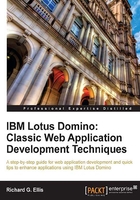
Chapter 2. Design and Development Strategies
An application enhancement or development task can be daunting depending upon your experience and the size of the task. In practice Domino developers can play several project roles: analyst, architect, programmer, coder, tester, technical writer, and often database administrator, trainer, and help desk as well. New developers may be assigned modest enhancement assignments while the more experienced tackle the more challenging projects. But you may not have a choice in the matter; you may be the only Domino developer in your organization and a part-time one at that.
Your goal is to align the application design with the business, to make users more productive more effective, accurate, and timely. The more you know about the business jargon, processes, priorities, and problems, the better positioned you are to interpret user requirements, and to offer suggestions for enhancing an application.
Your application should satisfy user requirements and launch as defect-free as possible, as defects and errors impact productivity and create rework for users, developers, administrators, and managers. Good planning, design, development, and testing will ferret out most issues before the code reaches production.
Topics in this chapter focus upon general design and development considerations which apply to most projects:
- Planning the design
- Applying standard practices
- Attending to human factors
- Using appropriate design elements and techniques
- Testing and promoting the design to production